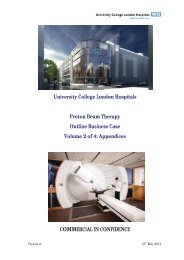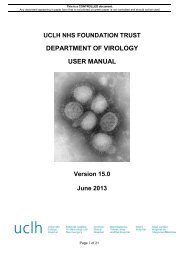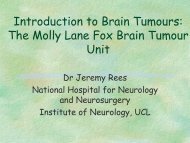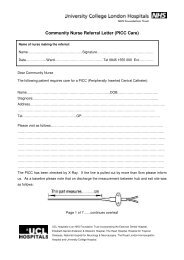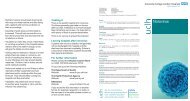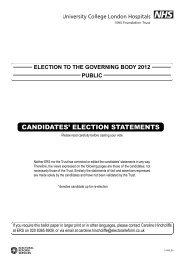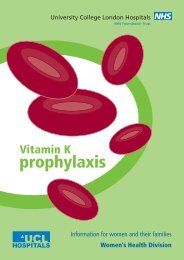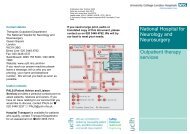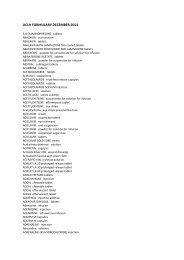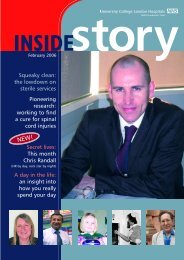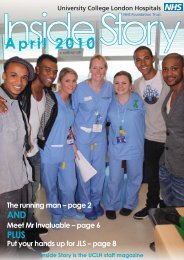How patients have helped us with our research - University College ...
How patients have helped us with our research - University College ...
How patients have helped us with our research - University College ...
Create successful ePaper yourself
Turn your PDF publications into a flip-book with our unique Google optimized e-Paper software.
14 12 UCLH BIOMEDICAL RESEARCH UNIT<br />
Patients find new ways of describing pain<br />
Patients <strong>have</strong> been working<br />
<strong>with</strong> a visual artist and clinicians<br />
in a pioneering project at<br />
UCLH’s Eastman Dental Hospital<br />
– one of the UK’s few national<br />
centres of excellence for facial<br />
pain.<br />
The aim of the project is to<br />
boost the quality of facial pain<br />
consultations. If a patient can<br />
describe clearly how pain feels<br />
– for example, whether it’s<br />
stabbing, dull, or like an electric<br />
shock – then it is easier for<br />
doctors to identify what type of<br />
pain it is and the best way to<br />
treat it.<br />
Visual artist Deborah Padfield<br />
is working <strong>with</strong> facial pain<br />
specialist Professor Joanna<br />
Zakrzewska on a study to find<br />
out whether visual images of<br />
pain can help communication<br />
between doctors and <strong>patients</strong>.<br />
It can be very difficult for<br />
<strong>patients</strong> to find the words to<br />
describe their experience of<br />
pain. “Patients try to explain<br />
their pain, but very often j<strong>us</strong>t<br />
say that it’s very severe or like<br />
a toothache,” says Professor<br />
Zakrzewska.<br />
Deborah works <strong>with</strong> <strong>patients</strong><br />
to co-create images which<br />
reflect their experience of pain.<br />
“People often do <strong>have</strong> an<br />
image in mind,” she says. “The<br />
challenge is to translate that<br />
into a photographic form which<br />
is realisable and communicates<br />
beyond literal description.<br />
I think the images are more<br />
powerful beca<strong>us</strong>e they combine<br />
both <strong>our</strong> strengths.”<br />
Being heard is a key<br />
step in a patient’s<br />
ability to manage<br />
their pain<br />
One patient brought in a tree<br />
branch to be photographed,<br />
beca<strong>us</strong>e it represented shooting<br />
pain “like lightning.” Another<br />
patient described her pain<br />
as like “being sandwiched<br />
between two slices of bread”.<br />
Professor Zakrzewska says:<br />
“So many <strong>patients</strong> tell <strong>us</strong>,<br />
‘Thank you for listening. It’s the<br />
first time someone understands,<br />
and hasn’t j<strong>us</strong>t told me that it is<br />
all in my mind.’” Being heard is<br />
a key step in a patient’s ability<br />
to manage their pain, she says.<br />
The project will be tracking the<br />
images <strong>patients</strong> create to see<br />
how pain is perceived before,<br />
during, and after treatment.<br />
This can be <strong>us</strong>ed to measure<br />
how well clinicians <strong>have</strong><br />
understood and responded to<br />
<strong>patients</strong>’ needs.<br />
The project will also enable<br />
clinicians to build up a bank of<br />
images, in the form of a pack of<br />
pain cards, they can <strong>us</strong>e in pain<br />
consultations.



